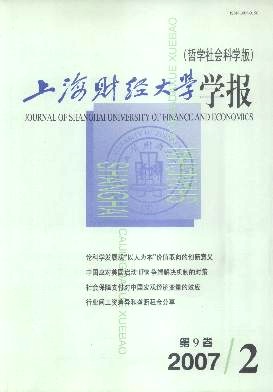论建立比例上限的常态国债余额管理制度
上海财经大学学报 2007 年 第 09 卷第 02 期, 页码:60 - 67
摘要
参考文献
摘要
自2006年起,我国开始采取国债余额管理制度进行政府债务管理。但国债余额管理制度仍存在一些问题需要进一步讨论,目前国内相关研究几乎是空白。本文研究了国债余额管理的必要性和有效性以及制度设计问题,认为我国国债余额管理制度仍有实施的必要性,应建立常态管理的、设置一定的国债余额比例上限的国债总余额管理制度,并优化完善国债余额的计算方法和统计口径。
[1]Congressional Budget Office.The Economic and Budget Outlook:An Update 52[R].1995.
[2]General Accounting Office.A New Approach to the Public Debt Legislation Should be Considered[R].FGMSD-79-58.Washington,D.C.:September 7,1979.
[3]Kogan,Richard.Refining the Debt Ceiling Poses Unnecessary Risks[R].Center on Budget and Policy Pri-orities,2004.
[4]Krishnakumar,Anita S.In Defense of the Debt Limit Statute[J].Harvard Journal on Legislation,Winter2005,Vol.42,No.1:135~185.
[5]Orszag,Peter and Greenstein,Robert.Federal Debt:What Matters and Why[R].Center on Budget andPolicy Priorities,Feb.22,1999.
[6]Schick,Allen.The Role of Fiscal Rules in Budgeting[J].OECD Journal on Budgeting,2004,Aug.12:17~23.
[7]马洪范.国债余额管理、国库现金运作及货币政策协调[J].中国金融,2006,(6):28~30.
[8]宋永明,梁春满.公债管理政策有效性的理论分析[J].财经研究,2003年,(8):15~21.
[9]王文刚,宋永明.相对独立的公债管理体制:分析与借鉴[J].经济体制改革,2004,(2):130~133.
[10]韦士歌.关于我国实行国债余额管理的几点思考[J].上海投资,2003年,(4):10~12.
[11]徐寒飞,方增平.国债余额管理制度对货币政策效应的影响[J].中国金融,2006,(6):30~32.
①Office of Management and Budget,historical tables,Budget of the United States Government,Fiscal Year2006(http://www.whitehouse.gov/omb/budget/fy2006/pdf/hist.pdf).
②董德志:《2006年中国债券市场回顾与2007年市场展望》,中国债券信息网(http://www.chinabond.com.cn/chinabond/article/content.jsp?sId=37500&sLmId=201)。
③一些研究文献将“国债增量管理”叫做“国债流量管理”。严格地说,这两个概念并不完全一致。例如,如果政府大量发行一年内的短期国债,那么在一年中,国债流量可能非常大,但国债余额增量可能很小。
④比例上限方法还有一种变形形式:增长率上限,即以债务的一定增长率设限,如政府债务余额增长率不得超过经济增长率,或设定某一百分比。
⑤黄金法则是英国财长布朗在1997年的首度预算演说中自创的名词,也是多年来布莱尔政府始终在名义上遵循着的法则。
⑥The Concord Coalition Issue Brief:Understanding the Federal Debt Limit,p2,2006/02/17.(http://www.concordcoalition.org/issues/feddebt/doc/060130UnderstandingDebtLimit.pdf).
[2]General Accounting Office.A New Approach to the Public Debt Legislation Should be Considered[R].FGMSD-79-58.Washington,D.C.:September 7,1979.
[3]Kogan,Richard.Refining the Debt Ceiling Poses Unnecessary Risks[R].Center on Budget and Policy Pri-orities,2004.
[4]Krishnakumar,Anita S.In Defense of the Debt Limit Statute[J].Harvard Journal on Legislation,Winter2005,Vol.42,No.1:135~185.
[5]Orszag,Peter and Greenstein,Robert.Federal Debt:What Matters and Why[R].Center on Budget andPolicy Priorities,Feb.22,1999.
[6]Schick,Allen.The Role of Fiscal Rules in Budgeting[J].OECD Journal on Budgeting,2004,Aug.12:17~23.
[7]马洪范.国债余额管理、国库现金运作及货币政策协调[J].中国金融,2006,(6):28~30.
[8]宋永明,梁春满.公债管理政策有效性的理论分析[J].财经研究,2003年,(8):15~21.
[9]王文刚,宋永明.相对独立的公债管理体制:分析与借鉴[J].经济体制改革,2004,(2):130~133.
[10]韦士歌.关于我国实行国债余额管理的几点思考[J].上海投资,2003年,(4):10~12.
[11]徐寒飞,方增平.国债余额管理制度对货币政策效应的影响[J].中国金融,2006,(6):30~32.
①Office of Management and Budget,historical tables,Budget of the United States Government,Fiscal Year2006(http://www.whitehouse.gov/omb/budget/fy2006/pdf/hist.pdf).
②董德志:《2006年中国债券市场回顾与2007年市场展望》,中国债券信息网(http://www.chinabond.com.cn/chinabond/article/content.jsp?sId=37500&sLmId=201)。
③一些研究文献将“国债增量管理”叫做“国债流量管理”。严格地说,这两个概念并不完全一致。例如,如果政府大量发行一年内的短期国债,那么在一年中,国债流量可能非常大,但国债余额增量可能很小。
④比例上限方法还有一种变形形式:增长率上限,即以债务的一定增长率设限,如政府债务余额增长率不得超过经济增长率,或设定某一百分比。
⑤黄金法则是英国财长布朗在1997年的首度预算演说中自创的名词,也是多年来布莱尔政府始终在名义上遵循着的法则。
⑥The Concord Coalition Issue Brief:Understanding the Federal Debt Limit,p2,2006/02/17.(http://www.concordcoalition.org/issues/feddebt/doc/060130UnderstandingDebtLimit.pdf).
引用本文
郑春荣. 论建立比例上限的常态国债余额管理制度[J]. 上海财经大学学报, 2007, 9(2): 60–67.
导出参考文献,格式为:
下一篇:行业间工资差异和垄断租金分享





 7127
7127  139
139

